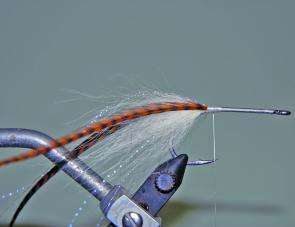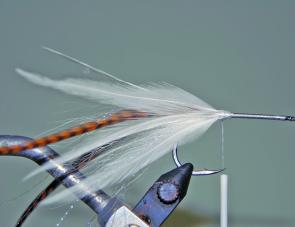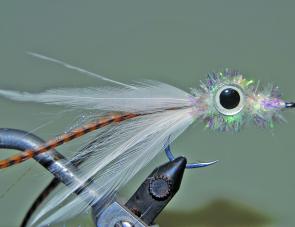Various squid species (cephalods) are on the increase throughout Southern Queensland waters. Several different varieties can be located around the channels and shallow reef, weed bed and rocky areas. Squid make up a portion of the diet for many different species of fish so naturally having a few squid pattern flies in your line-up is a must.
Bottle squid are one of the smaller species that can be a prime food source for everything from flathead and snapper to longtail tuna and cobia. This month we will tie a simple Bottle Squid fly pattern, a classic, yet simple replica of this prominently preyed upon species.
Squid species will be on the increase in Moreton Bay waters throughout April and the upcoming months. Predating species that are prominent in the cooler months will naturally prey on these tasty morsels. Mulloway, snapper, longtail tuna, bream, trevally, sweetlip and flathead are just a few that are worth targeting with the Bottle Squid fly.
Even in the northern waters, squid are an integral part of the diet for many species, especially fingermark. I have even seen barramundi caught on live squid! Using this pattern when targeting various northern species makes good sense.
This basic squid replicating fly pattern can be varied in length. By using a hook with a 4X long shank you could easily produce a pattern to imitate the arrow squid. I have even tied it as small as a size 4 for chasing bream and other smaller species.
The materials used in the Bottle Squid are fairly simple yet they can be altered in some aspects for whatever you have at your immediate disposal. For the inner tail fibre I have used Arctic Fox Fur, however suitable substitutes could include Finn Raccoon, Polar Fibre or Marabou.
For the outer tail I have seen materials such as rubber leg stripping, badger hackles and neck hackle used instead of the saddle hackles. The longer feelers, or candles as they are often referred to, could be represented with a shape cut from a rubber glove or similar, however I like the natural barred look of the grizzly saddle hackles.
Deep-Sea eyes are made from aluminium and therefore have minimal weight, reducing the fly to a slow sink when at rest. If you wanted your pattern to sink quicker, perhaps for fishing in faster currents, then these could be substituted with Real Eyes or I-Balz. I have used a glo-in-the-dark pupil as the eye on real squid have a similar luminescence and are a prominent feature of the species.
I have also added some UV Krystal Flash for when the pattern is used in sunlight. It makes the squid look alive, adding realistic appeal to the pattern. For the body you could substitute many different types of chenille or could even use white or cream leech yarn.
As you can tell, there are many different material variations that can be made to this pattern, opening up all sorts of possibilities at the tying bench.
One only has to envisage how a squid swims to work out the best retrieves. Often they will suspend in the water column and at other times they make a hasty retreat with a series of short darting movements.
Squid mostly travel in a forward motion but can reverse when they want to attack their prey. With this in mind, we can solicit our Bottle Squid fly into realistic movements through a series of strips and pauses. As this pattern sinks slowly, it can be cast into a likely area and allowed to descend through the water column. A subtle, short and sharp strip as it sinks will create a darting movement that will get the tentacles movement realistically.
Generally I allow the Bottle Squid to sink into the strike zone and then retrieve with two or three short, yet sharp strips and sizeable pauses in between. Obviously the speed of the current and water depth will play a big part in how you work this pattern. Even casting up current and stripping the near limp line as the pattern is washed back towards you will work well but be ready to strip-strike when the Bottle Squid gets slurped down by a hungry predator. The realistic nature of this pattern also lends itself to deployment into a berley trail.
(1) Place the hook firmly in the vice and attach the thread with a jamb knot just behind the eye of the hook. Palmer the thread along the hook shank to the start of the bend. Cut a small portion of the Arctic Fox Fur and tie in at this point ensuring an even coverage around the hook shank. Whip finish and add a little vinyl cement.
(2) Over the Arctic Fox, tie in around 6-8 strands of Krystal Flash that are at least twice the length of it. Next, cut two similar profiled grizzly hackles and tie one on each side of the hook with the natural curvature facing outwards. The hackles should be at least twice the length of the Arctic Fox Fur. Whip finish and again add some vinyl cement.
(3) Cut 8-10 thin hackle tips from some medium saddle hackles. These should be fairly similar to each other and a little longer than the Arctic Fox Fur. Position these evenly around the hook shank as you tie them in one by one with the curvature of the feather facing outwards. Whip finish and add some vinyl cement.
(4) Tie in the butt of your Estaz chenille at this same point and whip finish. Stick the adhesive eye into the recess on the deep-sea eye. Hold it with one side facing up and coat with UV wader repair, allowing the glue to create a dome over the pupil to create a 3D effect. Put under the black UV light to instantly set the UV wader repair. Repeat the process with the other side of the eye.
Attach your deep-sea eye just in front of the previous tie in points with a series of figure-of-eight wraps. Whip finish and then palmer the thread forward to just behind the eye of the hook. Put some vinyl cement over the thread attaching the eye.
(5) Palmer the Estaz chenille around hook shank a few times and then around the eyes in a figure-of-eight pattern to fill in the recess evenly. Palmer the Estaz chenile back down the shank towards the hook eye, creating a tapered appearance to the pattern. Whip finish, add some vinyl cement and then cut away the remaining thread.
(6) When completed, the Bottle Squid looks almost good enough to cut into calamari rings. If fishing this pattern at night, exposing the eyes to some torchlight (candle power) will make them glow in the dark creating a deadly effect in the water that is sure to be noticed by any predating species in the area. Used day or night, the Bottle Squid is a productive pattern to fish.
MATERIALS
| HOOK: | Gamakatsu SL12S 4/0 |
|---|---|
| THREAD: | Flat-waxed nylon – white |
| INNER TAIL: | Arctic fox fur – white |
| FLASH: | Krystal flash – UV grey ghost |
| CANDLES: | Grizzly saddle – dyed brown |
| TENTACLES: | Saddle hackles – medium white |
| EYE: | Deep sea – aluminum |
| PUPIL: | Adhesive 5mm – glow with UV epoxy coating |
| BODY: | Estaz chenille – pearl |
| FINISH: | Vinyl cement |










